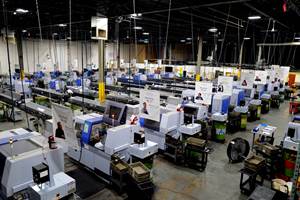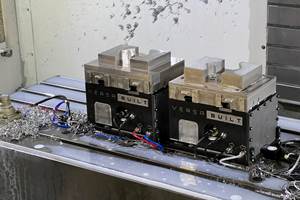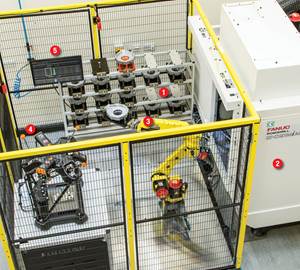The Right CAM Program Helps Machine Maker Meet Mandate
Mueller Tool and Machine's main focus is designing and building machinery that forms and finishes copper-tubing fittings for the plumbing and heating marketplace. Not available commercially, its custom machinery includes machines for facing copper fittings, and hydraulic presses with closed-loop programmable ram-control--which automate the push-forming of copper elbows.
Share






Mueller Tool & Machine, Inc. (Covington, Tennessee), a subsidiary of Mueller Industries, opened with the mandate to design and make special machines and tooling that would enable its parent company's production lines to produce copper-tubing fittings more productively.
"The special machinery that we build for our parent company's assembly lines has increased production and throughput at three of our facilities, but we still have 17 other locations waiting for us to design and supply similar tooling," says Jim Boshart, process and equipment engineer.
Mueller Tool and Machine's main focus is designing and building machinery that forms and finishes copper-tubing fittings for the plumbing and heating marketplace. Not available commercially, its custom machinery includes machines for facing copper fittings, and hydraulic presses with closed-loop programmable ram-control (which automate the push-forming of copper elbows).
The five-man design-engineering team uses CADKEY solid modeling software (CADKEY Corp. - formerly known as Baystate Technologies) on high-end PCs to design its machinery and tooling. Mr. Boshart put that CAD program in place because he had used it successfully at another location before joining Mueller to set up the Covington plant.
"We opened the plant with the ability to do CAD design with a 2D program having 3D wireframe capabilities," says Mr. Boshart. "Within just a few months, we saw that we needed the ability to do solid modeling to really achieve corporate expectations. So, in early '97 we switched to a new CADKEY 3D program, which saved us design time and errors by not requiring that we create separate views, from scratch, of each object we designed. Initially, we had to learn to think in 3D terms; but within six months, the new program had increased our design output dramatically, which allowed us to get more machinery and tooling out the door. At the time that it updated to 3D CAD, Mueller Tool & Machine also installed a leading CAM program to achieve the benefits of no longer having to write G-code programming to run in-shop CNC machinery. But soon the shop recognized that the program couldn't adequately handle solid-modeling ASIS input. For a solution, the shop turned to its CAD reseller, Mitch Free, of 3 Datum, and on his recommendation replaced its current CAM package with Virtual Gibbs Solid Surfacer, from Gibbs and Associates (Moorpark, California).
With Virtual Gibbs, the shop found that it took about one-fifth the time to generate CAM programming as before. A machined punch that required programming in four to five steps now could be completed in one step.
The shop was able to generate machining sequences that weren't possible with the previous program, and the new program was more stable. Programs that were previously generated and saved would now re-run flawlessly every time—without having to generate new geometry for repeat runs, as before.
"Virtual Gibbs really got our machines up and running and producing parts," Mr. Boshart emphasizes. "CAM download time was cut in half, which cut setup time in half for each CNC machine. This enabled a machine to begin cutting—and a second machine to be programmed and started—within the time frame formerly required to set up just one machine. One result was a doubling in our work capacity without adding additional machinery. Today, when you go into the shop, all of our machines are running and producing. That increase in uptime translates to dramatically increased production of parts.
The synergy of the CAD/CAM programming has been the key factor in meeting the operational mandate for Mueller's parent company, says Mr. Boshart.
Related Content
Inside the Premium Machine Shop Making Fasteners
AMPG can’t help but take risks — its management doesn’t know how to run machines. But these risks have enabled it to become a runaway success in its market.
Read MoreUsing Jaws as Grippers Enables Flexible, Low-Cost Automation
VersaBuilt’s automation systems significantly boosted Innovative Fabrication’s revenue. In return, the shop has helped VersaBuilt optimize its products.
Read More3 Ways Artificial Intelligence Will Revolutionize Machine Shops
AI will become a tool to increase productivity in the same way that robotics has.
Read More5 Stages of a Closed-Loop CNC Machining Cell
Controlling variability in a closed-loop manufacturing process requires inspection data collected before, during and immediately after machining — and a means to act on that data in real time. Here’s one system that accomplishes this.
Read MoreRead Next
Machine Shop MBA
Making Chips and Modern Machine Shop are teaming up for a new podcast series called Machine Shop MBA—designed to help manufacturers measure their success against the industry’s best. Through the lens of the Top Shops benchmarking program, the series explores the KPIs that set high-performing shops apart, from machine utilization and first-pass yield to employee engagement and revenue per employee.
Read MoreAMRs Are Moving Into Manufacturing: 4 Considerations for Implementation
AMRs can provide a flexible, easy-to-use automation platform so long as manufacturers choose a suitable task and prepare their facilities.
Read More



















